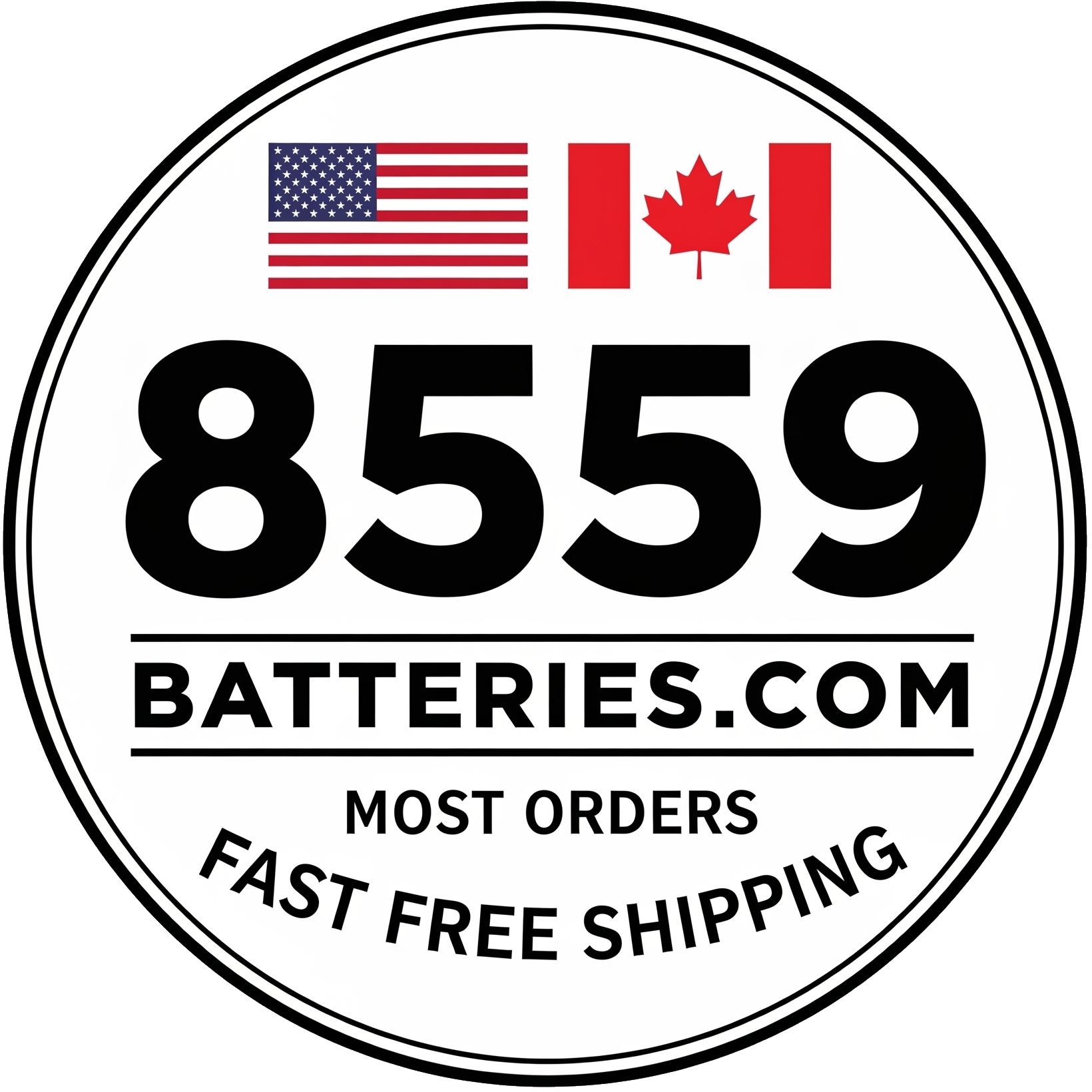Shop Products in USA
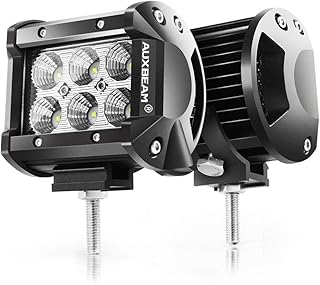
Auxbeam
LED Light Bar 4" 18W LED Pods 1800lm Flood Beam Driving light Off Road Lights for SUV ATV UTV Trucks Pickup Jeep Lamp (Pack of 2)
4.50
(3 reviews)
$22.49
Delivery Fri, Sep 12 Ships to Canada

Nilight
LED Light Bar 2PCS 60W 4 Inch Flood Spot Combo LED Work Light Pods Triple Row Work Driving Lamp with 12 ft Wiring Harness kit - 2 Leads
4.60
(8 reviews)
$21.06
Delivery Wed, Sep 10 Ships to Canada
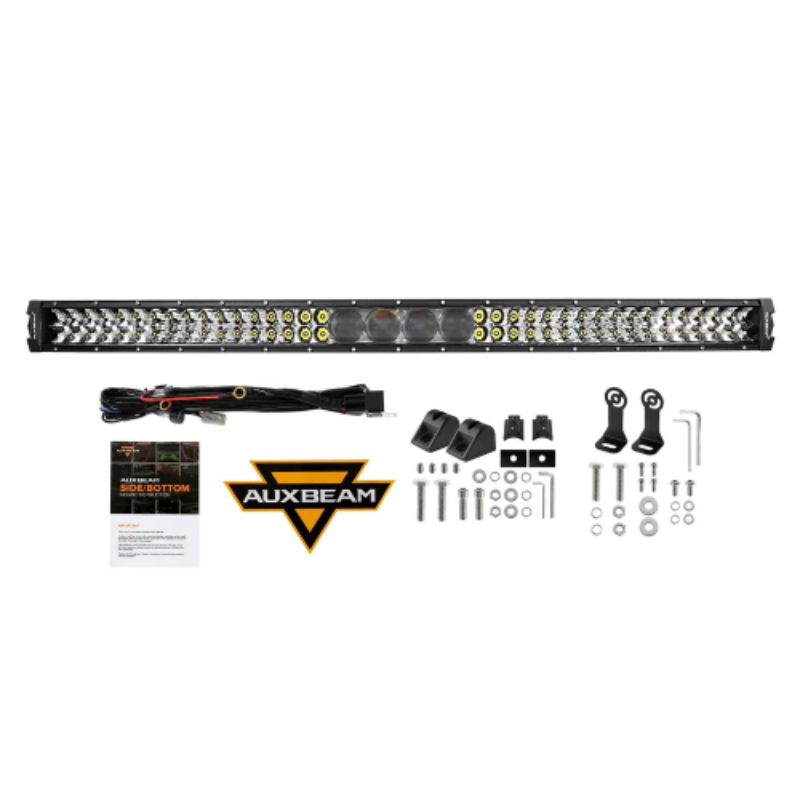
AuxBeam LED Light Bars
AuxBeam LED light bars deliver long-range spot and wide flood coverage for trucks, SUVs, UTVs, and work rigs. Choose single-row for low-profile installs or dual-row for maximum output; curved bars widen spread while straight bars concentrate reach. Rugged housings, sealed connectors, and harness options make installation straightforward—aim slightly down, use covers where required, and wire with a fused relay for reliable, legal operation.
About AuxBeam LED Light Bars
AuxBeam LED Light Bars: How to Choose, Install, and Aim
AuxBeam LED light bars provide usable distance with shoulder fill so you can see animals, ruts, and road edges earlier. This guide helps you pick the right bar, mount it securely, wire it safely, and aim it for maximum visibility with minimum glare.
Quick Recommendations
- Daily driver + trail runs: 20–30 in single-row combo on bumper/grille for low glare and quiet aerodynamics.
- Open desert or long gravel: 30–50 in straight dual-row combo for maximum reach; add ditch lights for corners.
- Wet, snowy, or dusty conditions: Use selective yellow lenses/filters on auxiliary fog/ditch lights; keep the bar white for distance.
- Tight trails/UTVs: Short (8–14 in) single-row or a pair of pods; roof racks benefit from curved bars for side awareness.
Form Factor: Use If / Avoid If
| Type | Use if | Avoid if |
|---|---|---|
| Single-row (slim) | Need stealth fitment, reduced wind noise, grille openings | Maximum output is the priority |
| Dual-row (high output) | Have space and airflow, need long throw + spill | Limited clearance or concerned about noise/weight |
| Curved | Want wider horizontal spread, matching bumper/roof contours | Need the tightest downrange focus |
| Straight | Prioritize reach on fast roads | Want edge-to-edge peripheral fill |
Beam & Color
- Spot: Highest candela for distance.
- Flood: Foreground and shoulder visibility.
- Combo: Balanced “set-and-forget” choice for most drivers.
- Color: White (≈5500–6500K) is crisp in clear air; selective yellow reduces glare in fog, rain, dust, and snow.
Fitment & Sizing
- Measure mounting width between brackets and allow 0.5–1 in for bracket adjustability.
- Low mounts (bumper/grille) reduce hood glare; roof/rack mounts see farther but can reflect off hood and dust.
- Check hood/antenna clearance at full open and suspension compression.
Installation (45–120 minutes with a premade harness)
- Plan the route: Keep wires away from heat, sharp edges, moving parts, and airbag deployment paths.
- Mounting: Use stout brackets, thread locker, and lock washers. Typical M8 hardware torque is 13–18 ft‑lb (check bracket spec).
- Electrical: Use a fused relay harness. Place the fuse within 6–8 in of the battery positive.
- Grounds: Clean to bare metal, use a star washer, then protect with dielectric grease.
- Label both ends of each wire for future service.
Wiring Essentials
- Current draw estimate: Amps ≈ Watts ÷ System Volts (e.g., 120 W ÷ 12 V ≈ 10 A).
- Fuse sizing: 125–150% of expected current (10 A draw → 15 A fuse).
- Wire gauge: ≤10 A run use 16–14 AWG; 10–20 A use 14–12 AWG; longer runs may require thicker wire.
- Switching: Tie relay trigger to high beams if desired, but keep a dedicated switch to disable the bar around traffic.
- Noise mitigation: Separate power from antenna/coax, add ferrite chokes if needed, and ensure solid grounds.
Aiming (5–10 minutes)
- Park on level ground 25–50 ft from a wall or use an open road shoulder.
- Aim so the hot spot lands slightly below the horizon line to extend usable sight distance and reduce glare.
- Road-test at speed; fine‑tune pitch to prevent foreground over-brightness.
Legal & Courtesy
- Many states allow off-road use only; covers may be required on public roads. Check local laws.
- Turn the bar off for oncoming traffic and when following others; use low‑glare fogs or chase lights in convoys.
Pros and Cons
- Pros: High candela reach, broad spill, robust housings, flexible mounting and wiring options.
- Cons: Potential wind noise (roof), glare if aimed too high, legal limits on-road.
Compatibility Notes
- Electrical: Most bars support 12 V and often 24 V systems; verify the product spec.
- Modern vehicles: Use a relay; connect only the relay trigger to factory circuits to avoid CAN bus faults.
- EMI: If you experience radio interference, reroute cables and add ferrites; ensure the chassis ground is clean.
Maintenance
- Re‑torque brackets after first 100 miles of driving and after heavy off‑road use.
- Inspect wiring, loom, and grommets quarterly; replace damaged zip ties and add abrasion protection.
- Clean lens with mild soap and water; avoid harsh solvents.
Troubleshooting
- Flicker on bumps: Re‑crimp or solder suspect joints; check for loose ground and connector pin push‑out.
- Moisture: Light fog after a wash can be normal; persistent droplets suggest a seal issue—dry thoroughly and reseal or contact support.
- No power: Verify fuse, relay click, switch power/ground, and battery connection order (fuse last).
FAQ
Do curved bars throw farther than straight bars?
No. Curved bars widen horizontal spread; straight bars concentrate intensity downrange for more reach.
Should I choose amber/yellow or white?
Use white for maximum contrast in clear air. Use selective yellow to cut glare in fog, rain, dust, and snow. Many drivers run a white bar and yellow fog/ditch lights.
Can I link the bar to my high beams?
Yes. Use the high beam circuit to trigger a relay, but keep a separate switch so you can disable the bar around traffic.
What IP rating should I look for?
Many quality bars list IP67–IP68 for water/dust resistance. Verify the specific rating on the product page.
How big of a bar can I power?
Calculate amps from watts and size the fuse/wire accordingly. Example: a 180 W bar on 12 V draws about 15 A; use 12–14 AWG and a 20–25 A fuse.
Shop Products in CANADA
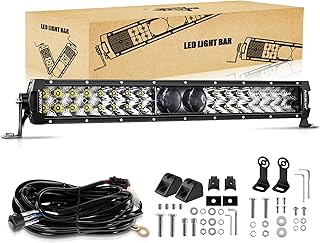
AUXBEAM
5D PRO LED Light Bar 180W LED
4.20
(137 reviews)
CAD $199.99
FREE delivery Thu, Sep 11Or fastest delivery Tue, Sep 9Only 7 left in stock.

NAOEVO
7 Inch LED Light Bar, LED Fog/Driving/Off Road Lights Spot&Flood LED Tractor Lights with 4 Leads Wiring Harness, LED Pods Lights Work Lights for Truck Boat ATV UTV, 4 Pcs (White)
4.40
(98 reviews)
CAD $82.99
FREE delivery Thu, Sep 11Or fastest delivery Tomorrow, Sep 8
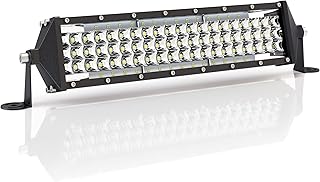
Zmoon
12 Inch LED Light Bar 264W, IP67 Waterproof Five Rows Spot & Flood Combo Beam LED Fog Light Bar for Truck ATV UTV SUV Tractor Boat Weeder etc.
4.40
(2 reviews)
CAD $34.99
FREE delivery Thu, Sep 11 on $35 of items shipped by AmazonOr fastest delivery Tomorrow, Sep 8
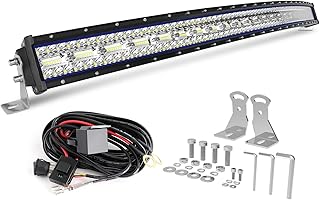
JG-AUTO
Curved LED Light Bar 42 inch 600W 65000LM Triple Rows Spot Flood Combo Light Off-Road Driving Lights with Wiring Harness High Brightness for Trucks SUV ATV UTV Marine
4.50
(259 reviews)
CAD $175.99
FREE delivery Thu, Sep 11Or fastest delivery Tue, Sep 9
